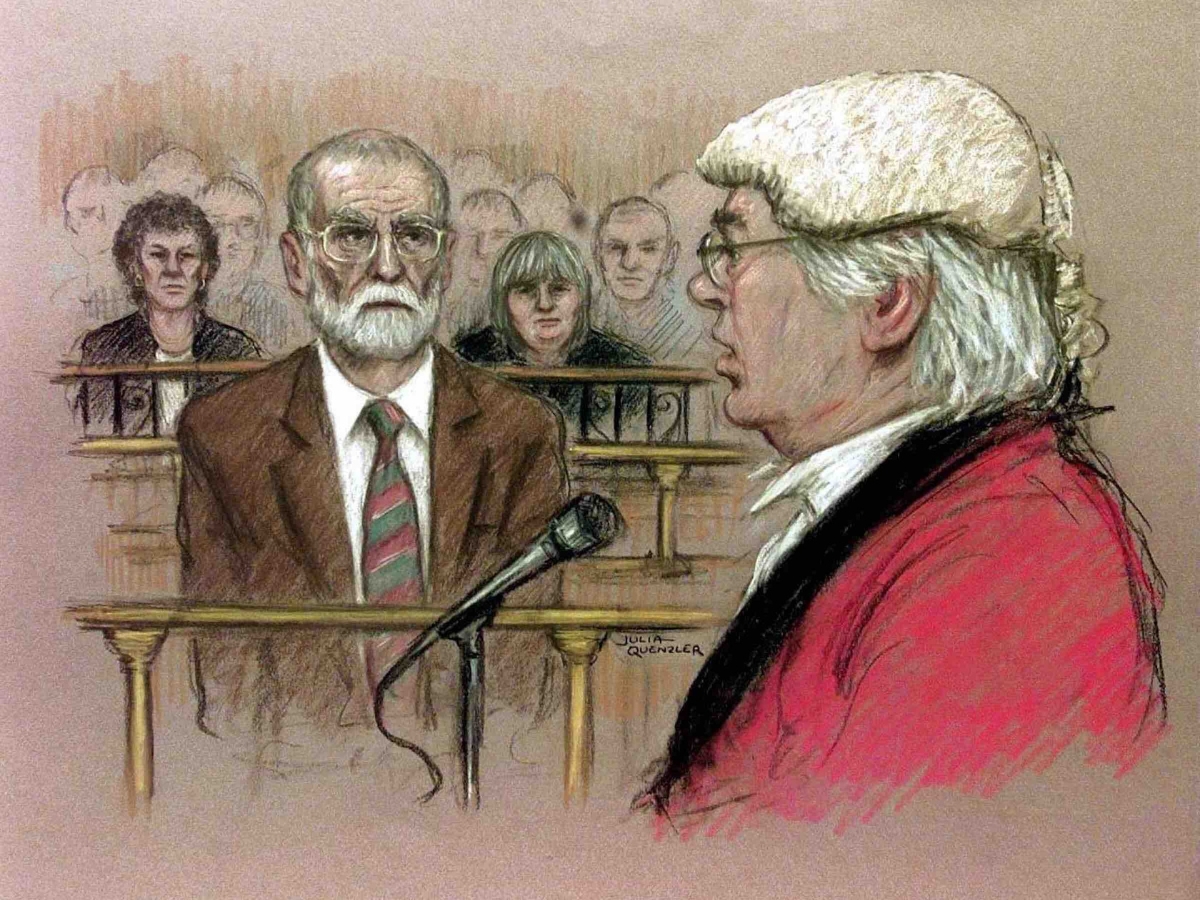Let us get to know a doctor who is better known as “Dr Death”.
The family doctor, a general practitioner whose duty was to preserve life, confirmed now as a mass murderer. The full extent of his crimes is yet unknown. Dr Harold Frederick Shipman of Hyde Manchester murdered 215 of his patients over 20 years. His reputation as a caring GP in a close-knit town was a thin veil for evil killings.
He committed the ultimate betrayal and callously murdered with lethal injection, making this a crime that shook Britain. The prosecution alleged that the GP enjoyed killing his patients. Harold Shipman ran a busy one-man surgery in a town of 22000 people. His patients held him in high regard. But Shipman held an unimaginable secret. One that goes against the oath of any doctor. He was killing his patients.
Shipman’s childhood, studies and his wife Primrose Shipman
Harold Frederick Shipman was born on January 14th, 1946 in Nottingham, England. He came from a modest working-class family and was affectionately nicknamed Fred. He was said to be a very bright child. A personal tragedy early in his life may have inspired his decision to go into medicine. As a teenager, he watched his mother die of lung cancer. He observed helplessly, as she was given injections of a high dose of diamorphine to ease the pain of her disease.
The very drug that he later used to murder his patients. In 1965 Shipman began his studies at Leeds University medical school and began dating Primrose May Oxtoby. She became pregnant with their first child not long after they met. They got married on November 5th 1966.
They had four children together and were seemingly an average happy family. Shipman graduated from medical school in 1970 and began working as a junior doctor in west Yorkshire. In 1974 he secured his first general practitioner position. Not long after he started there, his true colours began to show.
The beginning of his murder
In November 1997, Dr shipman conducted house calls. He visited Murray Quinn, a 67-year-old local lady, who had been a loyal patient for over 20 years. Shipman claimed to have found Murray unconscious and took the decision not to resuscitate. He seemed to have a variety of rhetorical tactics that he used to gaslight his patients and their families into respecting his authority.
He made a call to a relative and delivered the devastating news that she had died of a stroke. Shipman had a reputation for visiting his elderly patients at home. He called the Funeral directors himself. Though it seemed unusual, no one paid any heed to it. Later on, the most unusual thing that the Funeral directors felt was that he had a key to let them into Mrs Quinn’s house.
The Funeral directors also started to feel uneasy about some of Shipman’s deceased patients. Certain elements were just not adding up. And then, more alarm bells started to ring. On the 10th of December, another patient of Shipman died suddenly at her home. Bianca Promfritt was just 49 years old.
She lived alone and for many years she suffered from depression. However, she certainly did not have any serious health condition. Her medical complaints were not life-threatening. Apart from her frequent ailments, she didn’t have any complaints about other serious health issues. She thought very highly of her doctor.
One of her support workers called her and knocked on her door but couldn’t get any reply. Then she contacted Bianca’s son. After he came, the door was unlocked and they found Bianca dead.
In the following months, the funeral directors grew increasingly concerned as more of Shipman’s patients were found in unusual circumstances. It was very uneasy for them with the number of his patients that were dying.
The majority of them were women. Several patients died with no major ill health, and the doctor with one of the best reputations in medicine was under scrutiny. Dr Sue Booth, a general practitioner found it very suspicious and she wanted to discuss it with Dr Patel and the other trusted doctors.
She wanted to discuss with the fellow doctors what step they need to take. After Debbie, who was a funeral director, Dr Booth was called upon again by Dr Reynolds. She called her and said she had suspicions of Dr Shipman being a murderer. 20th march 1998, as the GPs at the neighbouring practice called an urgent meeting, Shipman went about his daily duties.
He was unaware that he was under suspicion. Therefore, he again started to conduct house calls. He visited one of his loyal patients, Ada Warburton. She was 77 years old. Shipman had visited her unannounced. However, Ada welcomed him regardless. He then called one of her relatives and said that she might have had a stroke.
A few days later, the doctors nervously awaited the results. They urgently needed to compare the death rates between their surgery and his patient’s deaths. It was astounding to notice that there were 41 occasions when Shipman had asked the other doctors to countersign permission forms over many months, whereas during the same period, the other doctors only had 14 deaths from around 10000 people.
Investigations on Harold Shipman
At that point, it had become quite obvious that he was killing his patients. As unbelievable as it sounded, it was true. Most of the doctors then started to believe that. In March 1998, officers from Greater Manchester police launched an investigation into the allegations against Harold Shipman. GPs, from surgery just 20 yards away, have discovered an alarming number of deaths from his practice and decided to contact the police via the coroner.
Despite the doctor’s reservation, the matter had to be investigated. DI Smith was assigned to the case. His first port of call was Dr Linda Reynolds, a fellow practitioner. As DI smith and Dr Reynolds discussed the concerns, one of Shipman’s patients, 88-year-old, Martha Marley, had just come off the phone to her daughter.
Her daughter usually called her every day at fixed times. Martha Marley seemed healthy when her daughter spoke to her early in the day. Later in the day, when she thought of giving her mother a call, as usual. But the routine was broken. Her mother didn’t pick up the call. In the meanwhile, Shipman went on with his daily routine.
Whilst, across the road, police were being told that he might be murdering his patients. However, DI Smith didn’t pay importance to the vital information. The relevance of a second doctor signing a cremation form, the availability of a body to an autopsy, the difference between the death rates of the two surgeries and the relevance of interviewing any other doctor at the practice. But this was a unique case and Smith wasn’t experienced in this kind of investigation.
When DI Smith left Brook’s surgery, Dr Shipman was busy with other patients. At 6: 45 PM, Martha Marley was found dead at her home. A body now lies in the morgue with similar characteristics as other patients’ deaths. All lived alone at home and with no major health complaints. But the investigation headed in a different direction, and the doctors in Brook’s surgery were back to normal.
Police hadn’t advised anything differently. Just two days later, another cremation form arrived from Shipman. As the investigation went underway, and Martha Marley’s body was to be put to rest, another of Shipman’s patients, Ada Warburton, whom he visited six days ago, also lied dead.
Two bodies could hold the key to Shipman’s crimes. DI smith turned his attention to the town hall to discover how many deaths have been registered by Shipman in the last six months. A discrete investigation continued. But Shipman continued to go about his duties as usual.
Two potential victims lie in the mortuary, about to be cremated. Dr Reynolds believed that those might held vital clues that were needed to Bring Shipman’s true colours to light.
However, Shipman convinced that no autopsies would be required. No autopsies had been ordered, vital evidence could have been lost forever. Later that day, Ada was cremated. Neither the Coroner nor Di. Smith was aware of Ada’s death.
They were also unaware of Martha Marley’s death. It was cremated the very next day. On 1st April 1998, it was one week into the investigation. DI Smith needed to see if there were any discrepancies in the death registered by Shipman. So, he decided to visit another doctor named Dr Banks.
He dealt with complaints about health practitioners in the area. When the police searched Shipman’s practice profile, they discovered that he had a less than average list of elderly patients and a smaller percentage of females than any other practitioners.
The chance of autopsies was gone, and to Di Smith, there appears to be nothing of concern in Shipman’s records but before closing the case, DI Smith visited the local cemetery to look at the number of cremations. Relatives of the deceased were also unaware that Shipman might have killed their loved ones.
A vital piece of the jigsaw puzzle was missing. Police were unaware that they were dealing with a man with a history of drug abuse. Possible victims had been cremated. When the test result arrived, it revealed high levels of diamorphine. But the case was closed. The police seemed convinced that the popular GP was guilty of nothing more than caring for his patients. But Dr Shipman goes on to kill three more women.
Three months had passed since the police investigation claimed that dr. Shipman was murdering his patients. His colleagues remained on edge while Shipman remained in practice and seemingly untouchable.
He didn’t seem to have feared the law at all. His next victim was Kathleen Grundy. He allegedly came to take her blood sample. Her death was certified as old age. But Kathleen’s legacy did not end there. Her message from beyond the grave was about to blow the lid on the country’s biggest serial killer.
Shipman’s imprisonment
On 14th July 1998, Kathleen’s daughter was contacted, to inform that they had a will, allegedly made by her mother, in which all her assets had been left to Dr Shipman. Kathleen’s daughter, Angela was left baffled by the news. Why leave a legacy to someone who wasn’t particularly close.
So, Angela herself started to investigate further. She started by comparing her mother’s signatures. The signatures did not match. Her fear grew. For the second time, Harold shipman came to police attention.
The devastating facts were going to get revealed. Dr Shipman had gone to Mrs Grundy for a blood sample as per what he said. But no blood had been taken from Mrs Grundy. He had callously murdered Kathleen and tried to forge her will to inherit nearly 400,000 pounds. Shipman’s elaborate plan was about to be foiled.
During mid-August, Shipman was well aware that he was under suspicion for murder and forgery. However, he carried on regardless. He was seeing patient after patient while officers swooped on his surgery to seize other potential evidence. He only showed contempt for the inconvenience caused. In September 1998, Dr Harold Shipman was arrested.
The results which came from the toxicology test indicated that diamorphine was found in Kathleen’s body. It was also found that the will was typed on Dr Shipman’s typewriter. He went to trial. He was convicted of 15 murders and forging a will. Then he was sentenced to life imprisonment.
Harold Shipman’s deathOn January 13th, 2004, just one day before his 58th birthday, Harold Frederick Shipman died by committing suicide at Wakefield Prison. Shipman’s death was an unsatisfactory outcome for many of the families of his victims who had wished him to suffer for a long time.

